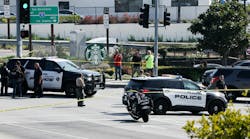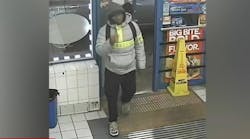RoboCop would be proud. Maybe even amazed.
Like the main character of the then-futuristic 1987 movie about an all-seeing humanoid cop, patrol officers are being equipped with the kind of high-tech communications gear that puts them on the cutting edge.
Officers are being wired to wear wide-angle miniature cameras on their uniforms that see and hear what they are seeing and hearing. They are being issued new smartphone-like devices so video of suspects or tactical situations can be fed to them in the field. Their cars automatically scan license plates and tip off officers who are about to encounter an ex-con.
Police departments are jumping headlong into social media, connecting with the community to turn the tables on crime. They are even writing their own blogs from their patrol cars so officers can keep each other updated about new events on their beats.
Even wilder stuff is on the horizon. One inventor, for example, is marketing a sleeve with a built-in video display, a camera, a laser beam and a stun gun for self-defense.
"Tech is huge in all aspects of law enforcement," said Albuquerque Police Chief Raymond Schultz after surveying the high-tech gear on display at the International Association of Chiefs of Police conference here earlier this month. "We continue to try to take it to the next level."
In his 1,014-officer department, going to the next level will include mandating wearable video cameras for all his street cops and requiring that the video be switched on whenever a call is answered. Schultz also is issuing smartphone-like devices that can send video or photos directly to officers in the field. Before they leave the station, Albuquerque officers headed out on the beat can see changing crime patterns on electronic bulletin boards.
Eyes on everything
Motorola Solutions, a huge supplier of police radios for decades and now also of laptops and other communications gear, is showing departments how a Ford Police Interceptor can be transformed into a rolling TV studio. A demonstration version of the car, Ford's law enforcement version of the Taurus sedan, is equipped with seven video cameras to cover every angle of an officer's encounters with the public, victims or suspects.
One camera, for instance, automatically scans license plates. That can be used to identify stolen vehicles or track down suspects. It also allows the car's computer to warn officers when they are making a traffic stop that they are approaching a parolee, ex-felon, fugitive or crime suspect.
Another camera aimed at the back seat records an arrestee's words and actions on the way to the slammer.
Instead of storing those hours of video in the car, the Motorola Solutions version has it constantly uploaded to a data center where it can be processed and stored. "We're trying to make the police car their mobile office," says Bob Schassler, a Motorola Solutions senior vice president.
If the police car sounds sophisticated, look what's coming for the cops themselves. Motorola Solutions not only envisions police wearing video cameras, but also heart-rate monitors so police operators know when the officer is in a high-stress situation. And a sensor records whenever they release the strap on their holster. That data, too, get fed back to the station.
The ideas and new gear are part of a drive -- called "next-generation 911" -- to modernize police dispatch and communications.
It is, in part, an effort to enable cops to use some of the same technology that the citizens they protect already use, such as sending text messages or video over secure channels.
Why shouldn't officers speeding to a crime scene be able to talk directly to victims without having to have all the information they need to know relayed through a dispatch center? Or if they encounter a barricaded suspect, why not be able to have schematic drawings of the location sent wirelessly to their smartphone screen?
"That's the future," says Michael Bostic, a former Los Angeles deputy police chief who works for Raytheon, another big tech supplier to law enforcement. "It's all going to be data."
The high-tech goodies aren't just going to officers in cruisers. Now, even police motorcycles are starting to be equipped with laptops that officers can use by the side of the road.
In a demonstration, Raytheon is equipping about 100 Los Angeles County Sheriff's motorcycles with laptops that deputies can pull out of a saddle bag during traffic stops and quickly fire up to use for license-plate checks and wanted-suspect inquiries.
High-tech 'sleeve'
Big corporations aren't the only ones with new ideas for high-tech communications for law enforcement.
Entrepreneur David Brown gave up his job as a technician in the film industry to pursue his dream of developing a sleeve that police officers can wear with a built-in video screen and a camera, a sort of full-sleeve update of Dick Tracy's two-way wristwatch.
The sleeve also has a laser pointer to light up potential troublemakers and a stun gun. One advantage of the sleeve over other versions of such gear is that it would be much more difficult to wrest away in a struggle.
Brown's company, ArmStar, based in El Segundo, Calif., is trying to market the sleeve to police departments and corrections agencies.
While much of the new technology and capabilities are built on forms of video, personnel at the police chiefs convention saw risks as well as opportunities in greater use of video and other real-time communications.
Police officers worry that video shot with body cameras will be regularly sought and used, in or out of context, by defense lawyers trying to find fault with their techniques or to try to document alleged brutality.
Increasingly, though, there is support in the ranks for more video because "we want the public to know the full facts of what occurred" when it comes to a controversial encounter, says Capt. Mike Parker of the Los Angeles County Sheriff's Department.
A bigger issue for departments is cost. And not just for the equipment.
With budgets already decimated by the recession, they are trying to figure out how to catalog and manage what would be, for a big department, thousands and thousands of hours of mostly routine video, part of which could become evidence in court cases.
"Do you know what it would take to store all that video?" Parker asks.
While the answer to that is "big money," Parker's department and others are finding some information technology solutions can be had without having to shell out a lot money.
One of the best examples is surveillance of social media. Parker says his department uses Twitter, monitors chat rooms and uses other social media to try to get ahead of potential crime problems. "Big Brother has become the people themselves," he says.
Social-media payoff
Planning a riot? The invitations will probably go out on Facebook or Twitter -- and deputies will be watching.
The strategy paid off recently when sheriff's deputies discovered the invitation for a rowdy rave with gallons of cheap booze. Acouple of officers paid a visit -- as full preparations were underway -- to issue a stern warning. That headed off what Parker says would have been the need for 20 deputies to show up in the middle of the night to break up the party.
"We get there before it's happening," he says. "We're not used to having that level of information."
In Tampa, police are putting social media to use in other ways. They have installed systems in their cars that create a department intranet.
Officers patrolling the community can type up their notes in a blog from their car and send them around to others. And officers returning from a few days off can use the blog to update themselves on issues that came up while they were off.
They can also use the system, called NC4 Safecop, to analyze neighborhood crime data -- right from the car.
"This is real-time information," says Tampa Police Chief Jane Castor. "Technology is invaluable for officers in the day-to-day crime fight."
Copyright 2012 Gannett Company, Inc.All Rights Reserved



